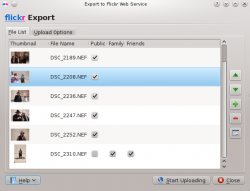KIPI: Difference between revisions
(Created page with "<languages /> {|class="tablecenter vertical-centered" |250px|| ||<translate><!--T:1--> '''KDE Image Plugin Interface - a common plugin...") |
No edit summary |
||
| Line 1: | Line 1: | ||
<languages /> | <languages /> | ||
<translate> | |||
{|class="tablecenter vertical-centered" | {|class="tablecenter vertical-centered" | ||
|[[Image:KIPI-Plugins-screenshot.png|250px]]|| || | |[[Image:KIPI-Plugins-screenshot.png|250px]]|| || | ||
'''KDE Image Plugin Interface - a common plugin structure for KDE applications''' | '''KDE Image Plugin Interface - a common plugin structure for KDE applications''' | ||
|} | |} | ||
KIPI (KDE Image Plugin Interface) is a common plugin structure used by KDE applications, including [[Special:myLanguage/Digikam|Digikam]], [[Special:myLanguage/KPhotoAlbum|KPhotoAlbum]], and [[Special:myLanguage/Gwenview|Gwenview]]. | KIPI (KDE Image Plugin Interface) is a common plugin structure used by KDE applications, including [[Special:myLanguage/Digikam|Digikam]], [[Special:myLanguage/KPhotoAlbum|KPhotoAlbum]], and [[Special:myLanguage/Gwenview|Gwenview]]. | ||
Revision as of 07:36, 5 June 2011
 |
KDE Image Plugin Interface - a common plugin structure for KDE applications |
KIPI (KDE Image Plugin Interface) is a common plugin structure used by KDE applications, including Digikam, KPhotoAlbum, and Gwenview.
Features
- Allows easily adding functionality without modifying a host application's code.
- May add extra menus and shortcuts to host applications.
- Can manipulate images in many ways.
- Can send images to contacts, or upload to image galleries and social networking sites.
